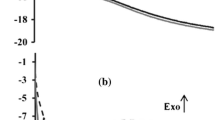Abstract
Precipitated silica is synthesized commercially by neutralizing sodium silicate solution under harsh conditions of pH and temperature. In contrast, the formation of ornate silica structures in biological systems (biosilicification) occurs at (or close to) pH 7 under ambient conditions and is thought to be mediated by proteins. Determination of the primary sequences of these proteins has led to the identification of various amino acids that have been proposed to be important in biosilicification. The corresponding synthetic polyamino acids are now being successfully used in bioinspired materials chemistry for developing new materials and processes. Here we report the formation of well-defined silica in vitro as facilitated by poly-L-arginine (PLAr) under ambient conditions and at neutral pH. Two different silica precursors were used in this investigation; tetramethoxysilane (TMOS) and water glass. Scanning Electron Microscopy (SEM) was used for studying the silica morphology and it was revealed that the silica spheres had typical diameters in the range 300–500nm. The PLAr is a cationically charged macromolecule at neutral pH and is believed to act as a catalyst/template/scaffold for the formation of silica in vitro in analogous fashion to certain biomacromolecules that are able to facilitate silicification/biosilicification. These results are discussed here in the context of the role(s) of (bio)macromolecules that facilitate (bio)mineralization.
Similar content being viewed by others
References
R. K. Iler, The chemistry of silica (Wiley, New York, 1979), (a) pp. 172.
T. L. Simpson and B. E. Volcani, eds., Silicon and Siliceous Structures in Biological Systems (Springer-Verlag, New York, 1981).
N. Kroger, R. Deutzmann, and M. Sumper, Science 286, 1129(1999). The amino acid structure and sequence of the silaffin proteins isolated from the diatom C. fusiformis has been revised in subsequent publications. The findings suggest that arginine residues may be proteolytically removed after translation of the silaffins.
L. L. Brott, D. J. Pikas, R. R. Naik, S. M. Kirkpatrick, D. W. Tomlin, P. W. Whitlock, S. J. Clarson, and M. O. Stone, Nature 413, 291(2001).
K. Shimizu, J. N. Cha, G. D. Stucky, and D. E. Morse, PNAS 95, 6234(1998).
C. C. Harrison (formerly Perry), Phytochemistry 41(1), 37(1996).
S. V. Patwardhan, N. Mukherjee, M. Steinitz-Kannan, and S. J. Clarson, Chem. Commun. 10, 1122(2003).
S. V. Patwardhan, N. Mukherjee, and S. J. Clarson, J. Inorg. Organomet. Polym. 11(3), 193(2001).
S. V. Patwardhan and S. J. Clarson, Silicon Chemistry 1(3), 207(2002).
S. V. Patwardhan and S. J. Clarson, manuscript in preparation.
S. J. Clarson, P. W. Whitlock, S. V. Patwardhan, L. L. Brott, R. R. Naik, and M. O. Stone, Polymeric Materials: Science & Engineering 86, 81(2002).
S. V. Patwardhan and S. J. Clarson, J. Inorg. Organomet. Polym. 13(1), 49(2003).
S. V. Patwardhan and S. J. Clarson, J. Inorg. Organomet. Polym. 12(3-4), 109(2002).
T. Coradin and J. Livage, Colloids and Surfaces B: Biointerfaces 21, 329(2001).
T. Coradin, O. Durupthy, and J. Livage, Langmuir 18(6), 2331(2002).
T. Coradin, C. Roux, and J. Livage, J. Mater. Chem. 12, 1242(2002).
L. Sudheendra and A. R. Raju, Mater. Res. Bull. 37, 151(2002).
J. N. Cha, G. D. Stucky, D. E. Morse, and T. J. Deming, Nature 403, 289(2000).
S. V. Patwardhan, N. Mukherjee, and S. J. Clarson, Silicon Chemistry 1(1), 47(2002).
S. V. Patwardhan, N. Mukherjee, and S. J. Clarson, Polym. Bull. 48(4-5), 367(2002).
S. V. Patwardhan, N. Mukherjee, and S. J. Clarson, J. Inorg. Organomet. Polym. 11(2), 117(2001).
T. Mizutani, H. Nagase, N. Fujuwara, and H. Ogoshi, Chem. Lett. 2, 133(1998).
C. C. Perry and T. Keeling-Tucker, J. Biol. Inorg. Chem. 5, 537(2000).
R. Tacke, Angew. Chem. Int. Ed. 38(20), 3015(1999).
W. Heller, Pure Appl. Chem. 12, 249(1966).
V. K. La Mer and T. W. Healy, Rev. Pure Appl. Chem. 13, 112(1963).
R. Borsali, in Handbook of Polyelectrolytes and Their Applications v. 2, S. K. Tripathy, K. Kumar, and H. S. Nalwa, eds. (American Scientific Publishers, California, 2002), Chap. 9.
S. V. Patwardhan, Ph.D. Dissertation, Department of Materials Science and Engineering (University of Cincinnati, 2003).
R. E. Hecky, K. Mopper, P. Kilham, and E. T. Degens, Mar. Biol. 19 323(1973).
Author information
Authors and Affiliations
Corresponding author
Rights and permissions
About this article
Cite this article
Patwardhan, S.V., Clarson, S.J. Silicification and Biosilicification Part 7: Poly-L-Arginine Mediated Bioinspired Synthesis of Silica. Journal of Inorganic and Organometallic Polymers 13, 193–203 (2003). https://doi.org/10.1023/A:1026120309903
Issue Date:
DOI: https://doi.org/10.1023/A:1026120309903




